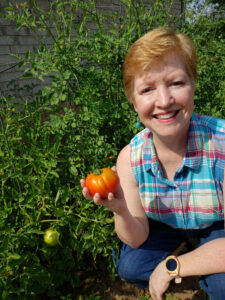
Every year, my husband and I raise vegetables. With everything strange this summer, our garden is a reminder that soil, sun, and water are constants. Of course, it’s up to us to put in the work. Did you know that planting a vegetable garden has a lot in common with creating an investment portfolio? Let me show how they are similar.
First, remember to diversify. This year, I planted tomatoes, peppers, squash, and watermelon. I also tried to grow an herb garden. Today, my tomatoes are taller than I am and loaded with red, pink, and green fruit! My peppers are bountiful, and the squash is surviving. My herbs are a total bust—nothing sprouted. However, overall, my garden is thriving.
Similarly, when you diversify your portfolio, you are more likely to earn a reasonable return. Maybe the bond funds you own aren’t doing well, but the stock funds are soaring. In more painful periods, the exact opposite could occur. If you own both stocks and bonds, you get the benefit of potential gains either way. You also cushion the impacts of possible losses.
In my garden, I’m growing both jalapeno and serrano peppers. Investing diversification can also be nuanced. You can select funds comprised of different sized companies—large, mid, or small. Internationally, you might purchase Europe or Asia, or choose between developed nations or emerging markets. You can dig deeper and explore different sectors of the market, like healthcare or technology. Bonds, too, can offer diversification. You can choose US or international government bonds, investment-grade corporates or high yield offerings.
Your newly selected diversified portfolio resembles the seeds I like to start in early spring. Although it’s tempting, don’t dig up your holdings every day to see if they have grown! Although you should follow your investment performance, you can lose perspective in daily movement. If you review a longer time horizon, like monthly gains or losses, you’ll experience less stress. Additionally, if you plan to make investment adjustments, select criteria in advance. Trading out of emotion can be risky.
Like your garden, you want your portfolio to grow. You can’t control the stock market, but you can make monthly contributions to your account. It’s amazing how small amounts add up over time. If you add $100 a month into your investment portfolio and earn an 8% rate of return, you will have $18,294.60 after ten years! That’s a terrific harvest!
Even when everything appears to be going well, keep insects and disease out of your portfolio garden. Review your investments for fees and performance. You want to be sure you aren’t paying too much money each year to own a fund. If you choose an investment with a manager, he or she should earn a return worth the fees. Be careful, though. Most fund managers don’t beat the appropriate indices!
Additionally, if you are working with a financial adviser, that person should always act in your best interest as your fiduciary. They should choose investments that will help you meet your goals, not provide them with a cruise! The fiduciary standard is a thorny issue in the financial services world right now. It’s up to you to ask tough questions. You don’t need an adviser who sucks up all your profits.
Finally, you want to know when your portfolio is ready to harvest. I’m a little worried about my watermelons. The last time I grew them, I eyed one carefully and waited until I was sure it was ripe. It wasn’t, but I discovered that after I picked it! To help you with your investment timeline, you need to decide why you opened the account. For most of us, the answer is to pay for our retirement. However, maybe you’re saving money to pay for your kids’ college. Or perhaps you want to buy a home in a few years.
The length of time until your goal will impact what kind of investments you should select. Generally, the longer you have, the more aggressive you can be. That way, if the market declines, you can still recover. If you have a short timeline, you may want to be more careful.
You also want to have a realistic expectation of how large your portfolio will have grown by the time you need it. I don’t expect my tomatoes to be as big as basketballs, and yet I talk to people who have unreasonable growth plans for their investments. Optimistically, the long-term return for stocks is about 11%, while bonds average 5%. If everything goes perfectly, a 50/50 portfolio will yield about 8% before inflation. If you’re more conservative than that or the markets turn sour, your return can be much less.
This summer looks nothing like I anticipated. However, taking the time to grow and tend a garden is providing tasty rewards. Your investment portfolio can be satisfying, too. Even if you’re working with a financial professional, understand why you are investing, what you own, and how much risk you are taking. A little attention now will help you enjoy the harvest of a well-planned future.

